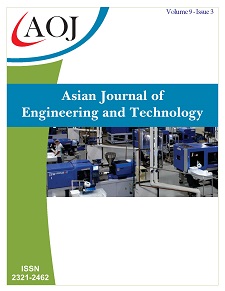Solution of SIR Infection Equation Using Data Assimilation
DOI:
https://doi.org/10.24203/ajet.v9i3.6663Keywords:
SIR Infection Equation, Data Assimilation, State Space Model, Bayes InferenceAbstract
The new coronavirus infection (COVID-19) is rampant. The most troublesome part of this infection is the time between infection and onset and the infectiveness for several days even in the not-onset state. Therefore, a considerable number of infected persons with infectivity are left unchecked. Therefore, even if the infection status is simulated by the SIR equation or the like, the true values of the infection parameters and the true number of infected persons cannot be grasped. However, it is possible to observe the infection status, and the daily number of infected people and the cumulative number of infected people are announced. These numbers are not true values, but they reflect true values. It is impossible to grasp the true value only by the SIR equation, but it will be possible to estimate the true value by combining it with the observation equation. In short, the data assimilation framework is considered to be effective. We report this effectiveness because we were able to confirm this effectiveness from the numerical results.
References
W. 0. Kermack, A. G. McKendrick, A Contribution to the Mathematical Theory of Epidemics, 1927, Proceedings of the Royal Society A (1927).
https://doi.org/10.1098/rspa.1927.0118.
H. Isshiki, M. Namiki, T. Kinoshita, R. Yano : Effective Infection Opportunity Population (EOIP) Hypothesis in Applying SIR Infection Theory, cornell arXive, arXiv:2009.01837 (2020).
https://arxiv.org/search/?query=Hiroshi+Isshiki&searchtype=all&source=header
G. Kitagawa, Use of a State Space Model in Time Series Analysis,Proceedings of the Institute of Statistical Mathematics, Vol. 67, No. 2 (2019) 181–192, in Japanese.
https://www.ism.ac.jp/editsec/toukei/pdf/67-2-181.pdf
K. Fukaya, Time series analysis by state space models and its application in ecology, Japanese Journal of Ecology, Vol. 66, No. 2 (2016), 375-389 in Japanese.
https://doi.org/10.18960/seitai.66.2_375
K. Law, A. Stuart, K. Zygalakis, Data Assimilation: A Mathematical Introduction, Springer (2015).
Downloads
Published
Issue
Section
License
Copyright (c) 2021 Hiroshi Isshiki

This work is licensed under a Creative Commons Attribution-NonCommercial 4.0 International License.
- Papers must be submitted on the understanding that they have not been published elsewhere (except in the form of an abstract or as part of a published lecture, review, or thesis) and are not currently under consideration by another journal published by any other publisher.
- It is also the authors responsibility to ensure that the articles emanating from a particular source are submitted with the necessary approval.
- The authors warrant that the paper is original and that he/she is the author of the paper, except for material that is clearly identified as to its original source, with permission notices from the copyright owners where required.
- The authors ensure that all the references carefully and they are accurate in the text as well as in the list of references (and vice versa).
- Authors retain copyright and grant the journal right of first publication with the work simultaneously licensed under a Attribution-NonCommercial 4.0 International that allows others to share the work with an acknowledgement of the work's authorship and initial publication in this journal.
- Authors are able to enter into separate, additional contractual arrangements for the non-exclusive distribution of the journal's published version of the work (e.g., post it to an institutional repository or publish it in a book), with an acknowledgement of its initial publication in this journal.
- Authors are permitted and encouraged to post their work online (e.g., in institutional repositories or on their website) prior to and during the submission process, as it can lead to productive exchanges, as well as earlier and greater citation of published work (See The Effect of Open Access).
- The journal/publisher is not responsible for subsequent uses of the work. It is the author's responsibility to bring an infringement action if so desired by the author.


